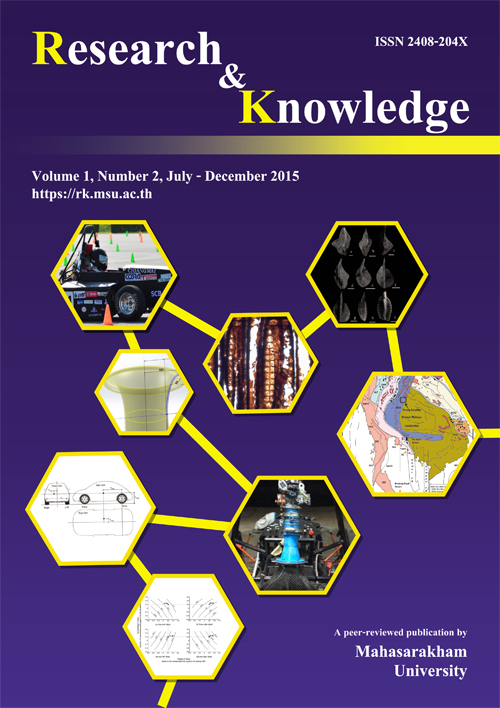Predictive suspension control system by inclinometer and accelerometer
Keywords:
Predictive suspension control, inclinometer, accelerometerAbstract
This paper presents a conceptual idea of a predictive suspension control system using two simple sensors, which are a bi-axial inclinometer and a bi-axial accelerometer, for measuring four input signals. The inclinometer is for measuring road parameters that consist of a slope angle and an incline angle, while the accelerometer is for measuring dynamic parameters that consist of an accelerating G-force and a turning G-force. A suspension control unit (SCU) is for calculating the four output signals using the concept of vehicle weight distribution. The percentage of the vehicle weight distributed to each wheel are the output signals for controlling the adjustable suspension parts, such as spring and shock absorber on each wheel independently. This article relates to the fi rst phase of developing a conceptual idea. However, the prototyping and experimental phases will be conducted in the next phase.
References
Armstrong L. D. 2010. Vehicle suspension kinetic energy recovery system. US20100006362 A1, 14-Jan-2010.
Donoso, A., Chacón, J. M., González Rodríguez, A. and Ureña, F. 2013. On an adjustable-stiffness spring composed of two antagonistic pairs of nonlinear leaf springs working in post-buckling. Mech. Mach. Theory 63, 1–7.
Dugard, L., Sename, O., Aubouet, S. and Talon, B. 2012. Full vertical car observer design methodology for suspension control applications. Control Eng. Pract. 20 (9), 832–845.
Fukumura, T., Shinbori, T., and Ezure, N. 1990. Car suspension system. US4921224 A, 01-May-1990.
Garrett, T. K., Steeds, W. and Newton, N. 2001. Motor vehicle, 13th ed. Warrendale, PA: Society of Automotive Engineers Inc.
Gillespie, T. D. 2014. Fundamentals of vehicle dynamics. Warrendale, PA: Society of Automotive Engineers Inc.
González Rodríguez, A., Chacón, J. M., Donoso, A. and González Rodríguez, A. G. 2011. Design of an adjustable-stiffness spring: Mathematical modeling and simulation, fabrication and experimental validation. Mech. Mach. Theory 46 (12), 1970–1979.
Henry, R. R., Applebee, M. A. and Murty, B. V. 1995. Full car semi-active suspension control based on quarter car control. US5475596 A, 12-Dec-1995.
Jazar, R. N. 2009. Vehicle dynamics: Theory and application, 3rd ed. Springer, New York.
Koch, G., Fritsch, G. and Lohmann, B. 2010. Potential of low bandwidth active suspension control with continuously variable damper. Control Eng. Pract. 18 (11), 1251–1262.
Lee, J. H., Yi, B.-J. and Lee, J. Y. 2012. Adjustable spring mechanisms inspired by human musculoskeletal structure. Mech. Mach. Theory 54, 76–98.
Milecki, A. and Hauke, A. 2012. Application of magnetorheological fl uid in industrial shock absorbers. Mech. Syst. Signal Process. 28, 528–541.
Naganathan, G. and Thirupathi, S. R. 1995. Active suspension systems and components using piezoelectric sensing and actuation devices. US5390949 A, 21-Feb-1995.
Popp, K., Schiehlen, W., Kröger, M. and Panning, L. 2010. Ground vehicle dynamics. Springer, Berlin.
Poussot-Vassal, C., Sename, O., Dugard, L., Gáspár, P., Szabó, Z. and Bokor, J. 2008. A new semi-active suspension control strategy through LPV technique. Control Eng. Pract. 16 (12), 1519–1534.
Poussot-Vassal, C., Spelta, C., Sename, O., Savaresi, S. M. and Dugard, L. 2012. Survey and performance evaluation on some automotive semi-active suspension control methods: A comparative study on a singlecorner mode. Annu. Rev. Control 36 (1), 148–160.
Rajamani, R. 2005. Vehicle dynamics and control. Springer, New York.
Downloads
Published
How to Cite
Issue
Section
License

This work is licensed under a Creative Commons Attribution-NoDerivatives 4.0 International License.








